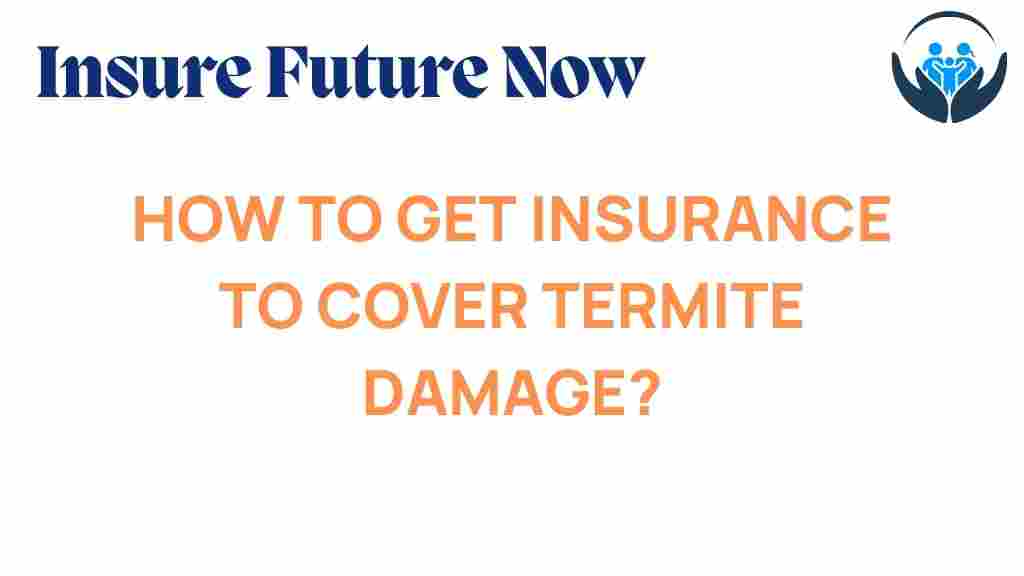Unlocking the Secrets: How to Get Insurance to Cover Termite Damage
Termites are often referred to as “silent destroyers,” and for good reason. They can cause significant damage to your home before you even realize there’s a problem. Understanding how to navigate the world of insurance coverage for termite damage is crucial for homeowners looking to protect their property. In this article, we will explore how to get your homeowners insurance to cover termite damage, the claims process, policy exclusions, and the importance of proactive pest control and mitigation strategies.
Understanding Termite Damage and Homeowners Insurance
Termite damage can lead to unexpected costs that can run into thousands of dollars. Many homeowners are unaware that homeowners insurance may not cover this type of damage due to various policy exclusions. Knowing the ins and outs of your policy can help you avoid costly out-of-pocket expenses.
Why Insurance Coverage for Termite Damage Matters
- Protect Your Investment: Your home is likely your largest investment. Adequate insurance coverage helps protect it from unexpected damage.
- Mitigate Costs: Timely coverage can save you from incurring significant repair costs.
- Peace of Mind: Knowing you have coverage can reduce stress when dealing with potential pest infestations.
The Claims Process for Termite Damage
To successfully file a claim for termite damage, follow these steps:
Step 1: Review Your Homeowners Insurance Policy
The first step in the claims process is to carefully review your homeowners insurance policy. Look for the following:
- Coverage Types: Check if your policy includes coverage for pest infestations and related damage.
- Policy Exclusions: Understand what is excluded in your policy regarding termite damage.
- Deductibles: Be aware of any deductibles that may apply to claims.
Step 2: Document the Damage
Before contacting your insurance company, it’s essential to document the damage thoroughly:
- Take Photos: Capture clear images of the damage, including any affected structures.
- Gather Evidence: Collect any evidence of termite activity, such as frass (termite droppings) or mud tubes.
- Get Expert Opinions: If possible, obtain a report from a licensed pest control professional.
Step 3: Contact Your Insurance Provider
Once you have all your documentation, reach out to your insurance provider:
- File a Claim: Provide them with all the details and documentation you have gathered.
- Follow Up: Keep a record of all communications and follow up regularly to check on the status of your claim.
Step 4: Work with an Adjuster
Your insurance company will likely send an adjuster to assess the damage. Prepare for this visit:
- Be Present: Ensure you are available to answer questions and provide additional information.
- Explain the Situation: Clearly articulate the extent of the damage and provide your documentation.
Step 5: Review the Adjuster’s Report
After the adjuster has assessed the damage, they will submit a report to your insurance company. Review this report carefully:
- Check for Accuracy: Ensure all the damage is accurately represented.
- Discuss Discrepancies: If there are any discrepancies, discuss them with your insurance provider.
Step 6: Receive Your Settlement
If your claim is approved, you will receive a settlement to cover the repair costs. Be sure to:
- Understand the Settlement: Know what costs are covered and any potential out-of-pocket expenses.
- Use Funds Wisely: Allocate funds for pest control and mitigation treatments to prevent future infestations.
Pest Control and Mitigation Strategies
Preventing termite damage is always better than dealing with repairs. Here are some effective pest control strategies:
- Regular Inspections: Schedule annual inspections with a licensed pest control professional.
- Moisture Control: Address any moisture issues in and around your home to make it less attractive to termites.
- Wood Treatment: Use treated wood for any new construction or repairs.
- Landscaping Practices: Keep mulch and wood piles away from your foundation to deter termites.
Common Policy Exclusions to Watch For
Understanding policy exclusions is crucial to know what your insurance coverage entails. Here are some common exclusions related to termite damage:
- Neglect: Damage resulting from lack of maintenance or neglect is often not covered.
- Pre-existing Conditions: If damage existed before your coverage began, it may not be covered.
- Specific Pest Exclusions: Some policies explicitly exclude damage from certain pests, including termites.
Troubleshooting Tips for Homeowners
If you encounter issues during the claims process, consider these troubleshooting tips:
- Stay Organized: Keep all documentation, receipts, and correspondence in one place.
- Know Your Rights: Familiarize yourself with your state’s insurance regulations.
- Seek Help: If needed, consult with a public adjuster or an attorney specializing in insurance claims.
Conclusion
Dealing with termite damage can be stressful, but understanding the claims process and your homeowners insurance policy can help you navigate this challenge effectively. By being proactive with pest control and mitigation strategies, you can protect your property from unexpected costs associated with termite damage. Remember, a well-informed homeowner is better equipped to make the most of their insurance coverage and secure their investment.
For more information on pest control and property protection, check out this comprehensive guide on pest management. Additionally, you can visit the official insurance website for more details on understanding your homeowners policy here.
This article is in the category Claims and created by InsureFutureNow Team
